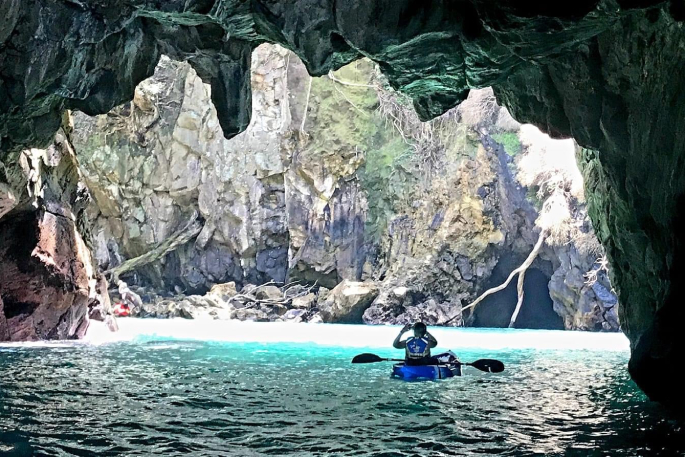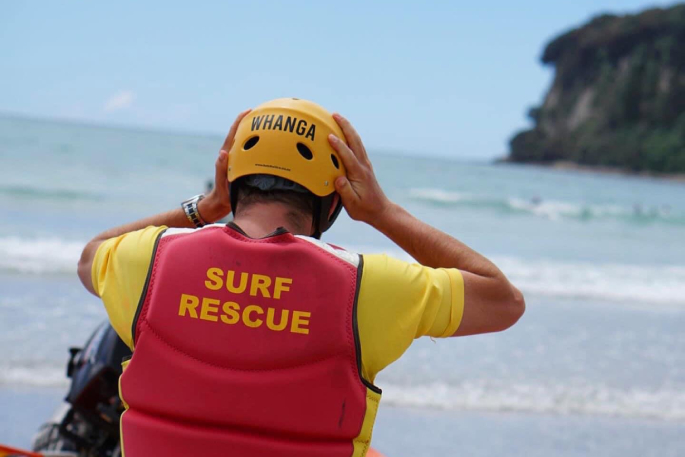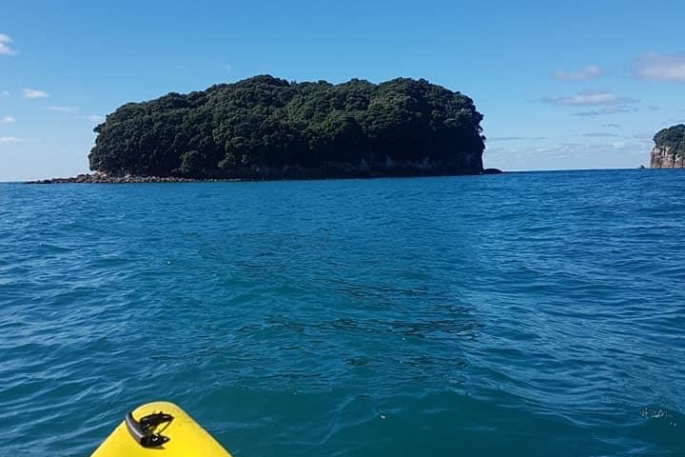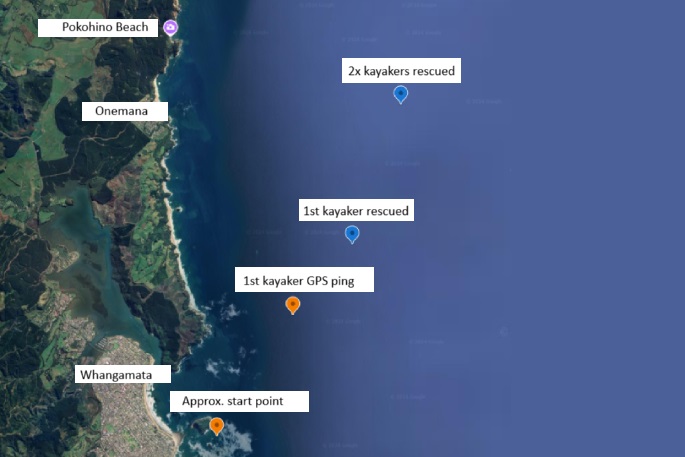A dramatic rescue operation unfolded off the coast of Whangamatā on Saturday morning after three kayakers were blown off course near Donut Island (Whenuakura Island), prompting a well co-ordinated response from multiple agencies.
Police said all four have since been recovered thanks to the response, and to the assistance of a local resident who was alerted to the incident and assisted the search with a private helicopter.
The incident is highlighting both the dangers of changing weather conditions and the importance of proper safety measures.
“About 8.40am, police were alerted to three kayakers who were unable to make it to shore and had been blown off-course. A fourth member of the group, on a paddleboard, was also unaccounted for,” the police said in a statement.
 Donut Island is a popular kayaking destination. Photo / Pippa Coombes.
Donut Island is a popular kayaking destination. Photo / Pippa Coombes.
While the paddleboarder managed to reach the shore on Whangamatā Beach, the three kayakers found themselves separated and adrift in increasingly challenging conditions.
Chaz Gibbons-Campbell, manager of Surf Life Saving New Zealand’s Eastern Region, detailed the unfolding events.
“The Whangamatā Surf Club Search & Rescue Squad were alerted to three kayakers and a paddle boarder stuck out at Whenuakura island around 9am and immediately initiated a search.
“We couldn’t find anyone. The paddleboarder had managed to get himself back to shore on the main beach but the three kayakers were missing,” said Gibbons-Campbell.
“So, it was a full-scale search following that. The three kayakers had been blown out to sea. Luckily, one of the kayakers had a mobile phone and we were able to locate them with the help of a private helicopter.”
 A Whangamatā Surf Life Saving volunteer. Photo: Supplied.
A Whangamatā Surf Life Saving volunteer. Photo: Supplied.
The police coordinated the search effort, which included volunteers from Coastguard Whangamatā, Coastguard Waihi Beach, Coastguard Tairua-Pauanui, and the Auckland Coastguard Air Patrol.
Gibbons-Campbell noted the critical role communication played in the operation.
“It’s essential for anyone heading out on the water to have two forms of communication. This could be a mobile phone, an Epirb, or a VHF radio,” he advised.
Bryan Black, a life member of the Whangamatā Surf Life Saving Club and owner of the helicopter that assisted in the search, recounted his experience during the rescue.
“When I saw the situation developing, I said to the constable on the beach ‘I’ll take my chopper, the wind is so strong, we can’t waste time’.
“We had our IRB out there, and it was really well-coordinated. The constable said, ‘Yes go for it mate’ so away we went.”
 Whangamatā Surf Life Saving Club. Photo: Supplied.
Whangamatā Surf Life Saving Club. Photo: Supplied.
Black said the Coastguard interface with Surf Life Saving was well-organised.
“Those people in the kayaks were motoring. My indicator was reading 35 knots out there; that’s about 38 mile an hour,” said Black.
“A kayak at 1000 feet is just a little spot. Fortunately, the guy in the kayak – he couldn’t speak to me, but he could text me to say whether I needed to come a little south or north. And then we found him. I was able to get through to the police constable on the beach, and with his mobile he called the coastguard and gave directions.”
“By the time they got the first person, the Coastguard Air Patrol arrived. It was about an hour into the search,” said Black.
“The paddleboarder made it to shore safely, however the remaining three were separated by differing currents and were located over one nautical mile away from each other, and over five nautical miles offshore,” said a police spokesperson.
“Trying to find the blinking kayaks in deeper sea, especially with the big chop there, they’re very lucky, those kids,” said Black.
“They had life jackets on, had reasonably good clothing, although I understand they had a bit of hypothermia. They were out there on the water for almost three hours.”
Gibbons-Campbell too expressed relief at their safe recovery, noting that all individuals were wearing life jackets and wetsuits, which significantly contributed to their survival.
“They were cold and tired but lucky to have made it back,” he said.
Gibbons-Campbell took the opportunity to remind the public about the unpredictable nature of coastal conditions.
“People often underestimate how quickly the weather can change. Today’s incident reinforces the need for everyone to check forecasts before going out and to prioritise safety measures.”
Gibbons-Campbell said the Whangamatā Surf Life Saving Club was operating out of temporary facilities containers while trying to fundraise $400,000 for clubroom renovations.
 Whangamatā Surf Life Saving Club are needing help to raise $400,000 to complete the rebuild of the clubrooms. Photo: Supplied.
Whangamatā Surf Life Saving Club are needing help to raise $400,000 to complete the rebuild of the clubrooms. Photo: Supplied.
We’re rebuilding our clubrooms, and they won’t be finished in time," said Black.
"Aaron Powell, who owns Just Sheds, has donated portacoms for our patrol and first aid, alongside sea containers for our lifesaving sports, right through until February.
“The club rooms are used for school activities, police use them for search and rescue meetings, we use them for all our sports and recreation, sporting clubs use it, it’s a community facility.
“It’s not just the Whangamatā Surf Club, we obviously use it for patrols, but it’s available for all the schools, from Hamilton, Auckland, Waikato all over the place.”
Information on Project Transform can be found here – https://projecttransformwslsc.co.nz
 Artist's rendition of the future Whangamatā Surf Life Saving Club. Image: Supplied.
Artist's rendition of the future Whangamatā Surf Life Saving Club. Image: Supplied.
As the Whangamatā Surf Life Saving Club along with most of the other eastern region clubs prepare for the upcoming Labour Weekend patrols, Gibbons-Campbell encourages people to check the Safe Swim website for patrol dates.
Police ask anyone planning to go out on the water, including when you are boating, kayaking or paddleboarding, to wear a life jacket.
Police advise outdoor enthusiasts to always check weather and ocean forecasts before setting out on your journey.
“[On Saturday] high winds were forecast, which likely contributed to the incident,” said police.

Whenuakura / Donut Island, off the coast of Whangamatā , is a popular kayaking destination. Photo: Scott Baker.
Whenuakura / Donut Island, lies about 600m off the coast of Whangamatā in the Coromandel Peninsula.
The island features a secluded turquoise lagoon, surrounded by native fauna and volcanic cliff rock. Due to its Wild Life Sanctuary status, visitors are to stay in the water, ideally on kayaks.



0 comments
Leave a Comment
You must be logged in to make a comment.